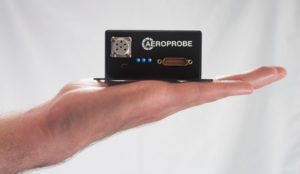 10-year old, VA-based Aeroprobe understands that improved air information leads to better flight efficiency and safety.
10-year old, VA-based Aeroprobe understands that improved air information leads to better flight efficiency and safety.
Aeroprobe produces sophisticated air flow data technologies used across industries. Their highly precise, multi-hole technology is critical equipment for anything that moves: Formula 1 racecars, wind turbines, space shuttles, helicopters and now, drones.
Aeroprobe has miniaturized their equipment in order to make it available to drones. With two new Micro Air Data Computers – which company CEO Nanci Hardwick describes as weighing about the same as a cell phone – any size aircraft can take advantage of the technology. These new offerings – named Pegasus and Destiny maintain the accuracy of the larger models used in the automotive and other industries in smaller form.
While air flow data technology isn’t yet a common topic in commercial drones, it will be. The Micro Air Data Computers used in conjunction with an air data probe “offer a complete system for air flow data acquisition and analysis,” says Aeroprobe. “These products are used in the unmanned systems industry primarily for avionics to collect real-time air data for increased flight performance and stability…In addition to the standard airspeed, angle of attack, angle of sideslip, and barometric altitude measurements, all models include field programmable firmware, external GPS synchronization, and data logging or streaming capabilities.”
All of this adds up to precision flight – maximizing speed and efficiency in all kinds of atmospheric conditions. Hardwick explains the advantage of real-time precision air information.”There is a latency in GPS,” she says. “If a wind gust comes and puts you off track, how can GPS tell you where you are before you are already off-track? Real-time information solves this problem.”
As drones seek to fly faster while maintaining safety, “Understanding angle of attack is really important,” says Hardwick. “The margin of error is only a couple of degrees – maximizing flight speeds while staying out of trouble is critical.”
While Aeroprobe’s solution offers industry-leading equipment, Hardwick says that her field will only continue to make improvements adoption increases. “Precision flight is demanding innovation in this area. People will begin competing with each other on efficiency.”
Aeroprobe’s customers represent a wide range of applications – all of which require the ability to fly efficiently and effectively in all conditions. Customers include weather research drones in the extreme conditions of the Arctic and Zipline’s automated delivery drones in Rwanda and Tanzania – mission critical operations that cannot be grounded due to the wind. Facebook’s massive Aquila experimental Internet drone, designed to remain in the air for 90 days, also uses their equipment. With the new offerings, drones in any application can take advantage of precise and real-time air information to ensure flight efficiencies and speed in any environment.

Miriam McNabb is the Editor-in-Chief of DRONELIFE and CEO of JobForDrones, a professional drone services marketplace, and a fascinated observer of the emerging drone industry and the regulatory environment for drones. Miriam has penned over 3,000 articles focused on the commercial drone space and is an international speaker and recognized figure in the industry. Miriam has a degree from the University of Chicago and over 20 years of experience in high tech sales and marketing for new technologies.
For drone industry consulting or writing, Email Miriam.
TWITTER:@spaldingbarker
Subscribe to DroneLife here.







[…] 10-year old, VA-based Aeroprobe understands that improved air information leads to better flight efficiency and safety. Aeroprobe produces sophisticated air flow data technologies used across industries. Their highly precise, multi-hole technology is critical equipment for anything that moves: Formula 1 racecars, wind turbines, space shuttles, helicopters and now, drones. Aeroprobe has miniaturized their equipment in […] The post Aeroprobe: Improving Flight Efficiency in the Enterprise andSee Original Article […]